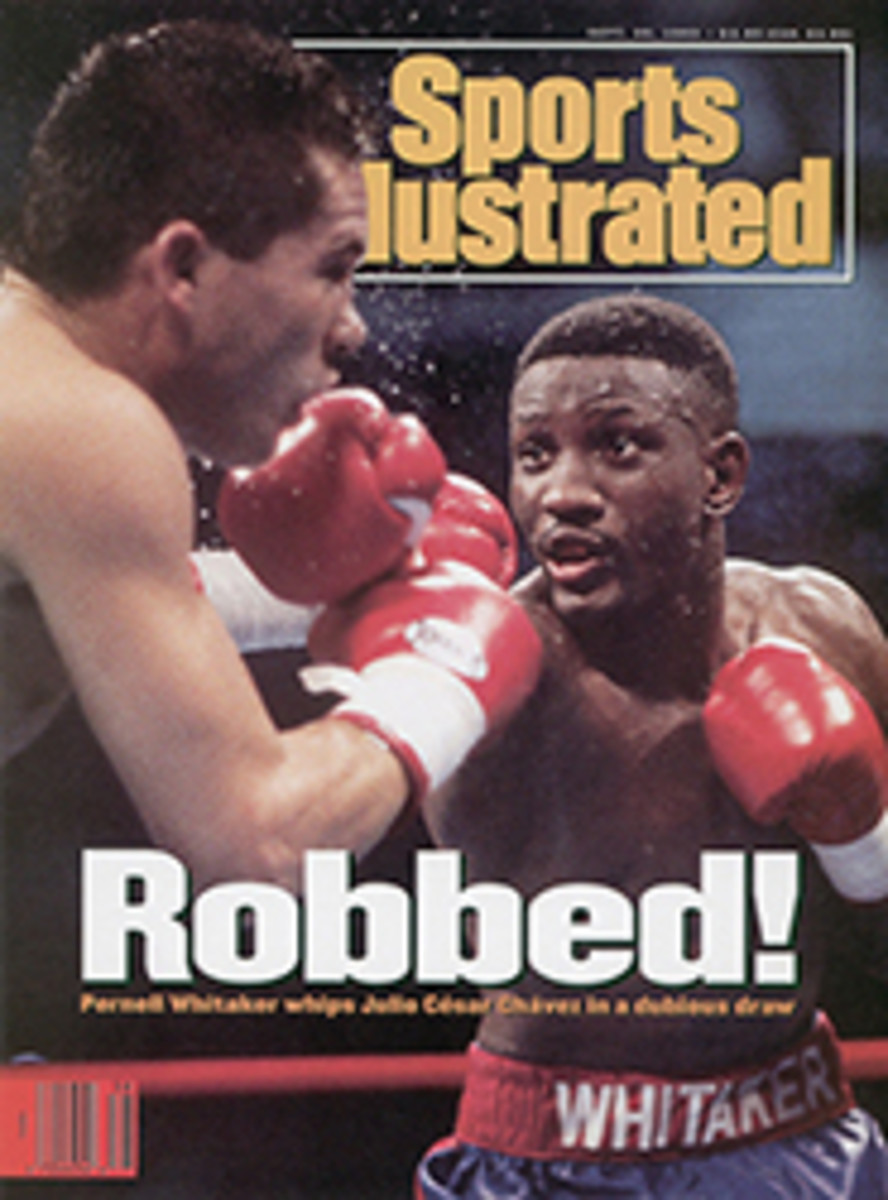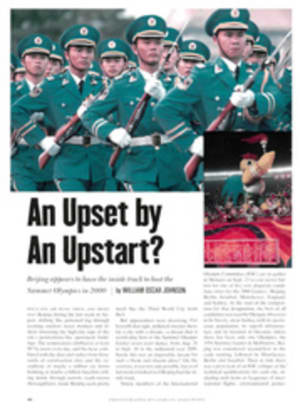
King of the Off-Road
The hands turning the steering wheel are thick and weathered, the skin beneath the fine dusting of blond hair a leathery brown. Under normal circumstances a ride with Ivan Stewart, off-road racing's most decorated driver, wouldn't allow the leisure for such intimate examination, what with all the cows and ditches and terrified motorists popping up into your field of vision like ducks in a shooting gallery. But Stewart isn't roaring through the desert. He's driving home after lunch, and his vehicle of choice is not $750,000 worth of consummately crafted truck but a Volkswagen van that has been stripped to its chassis and fitted with a white canopy. It looks like a jitney at a zoo.
Even when he is not racing, Stewart never leaves the driving to someone else. In June he celebrated his 48th birthday by winning his 12th Baja 500 off-road race—10 hours, 10 minutes and 39 seconds of sweat-stained, dust-choked hauling across 500 miles of mountainous terrain in Mexico. Afterward Stewart got into his Toyota vehicle and drove himself back to his hotel in Ensenada. "I don't like riding," he says. "It terrifies me. I have no control. If I get hurt, I want to do it myself."
Stewart excels in one of driving's most demanding arenas. Most off-road racers pair up for a reason. Races can last from eight to 30 hours, and negotiating terrain that often resembles the surface of the moon takes a physical and mental toll on the drivers. Besides, in the middle of the desert, help isn't always quick to arrive, and it's nice to have an extra pair of hands if a tire blows or you find yourself pinned upside down, wheels spinning in the sky, with a stampede of your fellow racers bearing down on you.
But Stewart pounds across the desert alone, his muscular frame hunkered down in the single seat that sits dead center in his truck's cab. Stewart has tried sharing the driving, but inevitably his partners have let him down, either by driving too cautiously to his liking or by becoming ill and vomiting, thus rendering themselves useless.
Long ago—before the 57 off-road wins, before the five SCORE World Championships, before the proliferation of Ivan Stewart video games—Stewart made the only rational decision. "I've always been strong enough to drive alone," he says, wheeling the VW into the hangar that serves as a garage on his spread in Alpine, Calif. "Why get out from behind the wheel when I don't have to?"
Driving alone works for Stewart. Everything in his life must work, or it has no purpose. Inside the house he shares with his wife, Linda, there are 50-year-old gumball machines, wooden clothes washers and ancient iron hunting traps. Outside there are farm implements from another era—manure spreaders, potato pickers and hay rakes.
And every piece works. If the spirit moves him, Stewart can pop a gumball in his mouth, hop in his teal-blue '64 Thunderbird, gas up at the gleaming cherry-red vintage '30s pump that stands outside of his garage and head for San Diego, 40 miles to the west. All is neat and tidy, too. Stewart will poke his head into the pantry and ask his wife why there is something other than cans in it. He is a man who has never had to hunt for a pair of matching socks.
"He's obsessive," says Linda, who has been married to Ivan for 30 years. "A real neat freak."
One of those rare souls who is comfortable with himself, Stewart doesn't argue the point. "I like to be organized," he says. "There's nothing worse than spending time that's unproductive. I'm happy when I'm getting things accomplished, heading toward a goal."
For the past 20 years that goal has been to drive faster than anyone else. Stewart chooses to do so in the dirt because off-road racing offers a certain spice not found on a track. "If you're racing at Indianapolis," he says, "odds are there's not going to be a cow out there."
Stewart still gets goose bumps when he remembers his first look at a major off-road race, the 1972 Baja 1000. "God, it was incredible," he says, his hands slashing the air in excitement. "They had these great big tires, and they went by so fast, throwing rocks and gravel, as they raced to La Paz. To me it was the ultimate adventure."
Actually, the task of the off-road driver is to eliminate as much of the adventure element as possible. Off-road racing is largely a game of attrition, drivers yanking their vehicles out of harm's way until fatigue or a mental lapse sends them plowing into an embankment or down into a ravine, jolting to a standstill in the quiet buzz of heat and dust. Stewart rarely makes such mistakes, and his stamina and focus have earned him the nickname Ironman.
He revels in his image and does what he can to foster it. For instance, you will never see a photo of a bedraggled Stewart. After every race he immediately tidies up, tucking his hair under his cap and sponging his face.
He is aided in this cosmetic repair job by the fact that most of his face has already been peeled off during the race. Most drivers wear enclosed helmets that pump in oxygen and fend off rocks and dust. Stewart chooses to wear an open-faced helmet and goggles, no trivial decision given that off-road vehicles have no windshields. As a result, his countenance is a cross between that of a matinee idol and an alligator handbag. "I don't like to be confined," he says. "Plus it's more of an incentive to gel in the lead."
Stewart also races in off-road stadium events, whipping his Toyota truck around dirt tracks rife with jumps, moguls and turns tighter than a dime so that 60,000 people can see what is usually witnessed only by buzzards and a canopy of sky. In 1990 he became the only driver to win both the overall stadium and the desert championships, but he much prefers racing in the great wide open.
Stadium races are short—12 minutes or less—and choked with other drivers, and you never know what your opponents are going to do. Stewart may also disdain the track because he invariably racks up more penalty points than any other driver in these events, banging fenders and bumpers in his desire to grab the lead.
"He's the most aggressive driver out there, no doubt. He puts a lot of punishment on people," says a competitor who has, on more than one occasion, been forced over a retaining wall by Stewart. No matter that this driver is Stewart's own son, Brian, who at 29 is five years into an off-road career of his own.
"I'm proud of the fact he's out there," says Ivan with a grin. "It's just too bad I've got to beat him."
"It makes Christmas interesting," says Brian.
Of course, Brian knows better than anyone else that there are two Ivan Stewarts: the intimidating man with the impressive knots of muscles in his chest and arms; and, away from the race, the affable, gregarious fellow with the chamber of commerce smile, who knows the value of remembering someone's name. At stadium events, while other drivers do their best to escape the throngs, Stewart likes to gab with fans and sign autographs almost right up to the beginning of a race.
"Absolutely a peach of a guy," says longtime friend and former off-road racer Parnelli Jones. "You'll never meet a nicer person. Aside from his driving."
The off-road world has changed a great deal since Stewart entered his first desert race, in 1973. No longer are drivers a bunch of yokels careering through the desert. At this June's Baja 500, Stewart's Team Toyota entourage included 18 support vehicles, a helicopter and a Cessna 172, and a hive of spiffily dressed technicians armed with tools so clean you could eat with them. These changes have benefited Stewart. But ultimately he has been successful because he hasn't changed at all; his enthusiasm flares brighter than ever.
"I wake up every morning and I can't wait to get going," he says, a smile spreading a few more creases across his face. "I've had a chance to live my adventure. What else could you ask for?"
PHOTO
ROBERT BECK
Stewart's racing headquarters is a converted airplane hangar on his California ranch.
PHOTO
CARRERA PHOTOGRAPHY
Stewart has conquered the forbidding Baja terrain more often than any other driver.
Ken McAlpine, a free-lance writer, has written several stories for Sports Illustrated.

